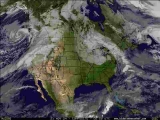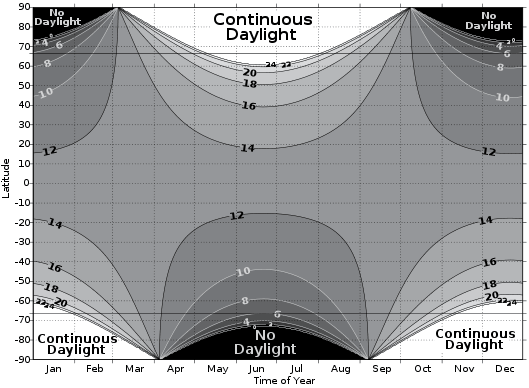Twilight
Twilight is the time between dawn and sunrise, and the time between sunset and dusk. Sunlight scattered in the upper atmosphere illuminates the lower atmosphere, and the surface of the Earth is neither completely lit nor completely dark. The sun itself is not actually visible because it is below the horizon. Due to the unusual and romantic quality of the ambient light at this time, twilight has long been popular with photographers and painters, who refer to it as "sweet light" or the "blue hour", after the French expression l'heure bleue. Twilight is technically defined as the period before sunrise and after sunset during which there is natural light provided by the upper atmosphere, which receives direct sunlight and reflects part of it toward the Earth's surface.
The collateral adjective of "twilight" is crepuscular (for daylight it is diurnal and for night, nocturnal). The term is most frequently encountered when applied to certain species of insects and mammals that are most active during that time.
Description and Definition of Sunrise/Sunset and Twilight Angles

Definitions
Twilight is defined according to the solar elevation angle 0s, which is the position of the geometric center of the sun relative to the horizon. There are three established and widely accepted subcategories of twilight: civil twilight (brightest), nautical twilight and astronomical twilight (darkest).
Civil twilight
Morning civil twilight begins when the geometric center of the sun is 6° below the horizon (the point of civil dawn), and ends at sunrise. Evening civil twilight begins at sunset and ends when the center of the sun reaches 6° below the horizon (the point of civil dusk). In general, civil twilight is the point where artificial illumination is required to read outside.
The brightest stars appear during the civil twilight, as well as planets, such as Venus, which is known as the 'morning star' and/or 'evening star'. During this period there is enough light from the sun that artificial sources of light may not be needed to carry on outdoor activities. This concept is sometimes enshrined in laws, for example, when drivers of automobiles must turn on their headlights, when pilots may exercise the rights to fly aircraft, or if the crime of burglary is to be treated as nighttime burglary, which carries stiffer penalties in some jurisdictions. A fixed period (most commonly 30 minutes after sunset or before sunrise) is typically used in such statutes, rather than how many degrees the sun is below the horizon. Civil twilight can also be described as the limit at which twilight illumination is sufficient, under good weather conditions, for terrestrial objects to be clearly distinguished; at the beginning of morning civil twilight, or end of evening civil twilight, the horizon is clearly defined and the brightest stars are visible under good atmospheric conditions.
Nautical twilight
Nautical twilight is the time when the center of the sun is between 6° and 12° below the horizon. In general, nautical twilight is the point where navigation via the horizon at sea is no longer possible.
At this time, sailors can take reliable star sights of well-known stars, using a visible horizon for reference. The end of this period in the evening, or its beginning in the morning, is also the time at which traces of illumination near the sunset or sunrise point of the horizon are very difficult if not impossible to discern (this often being referred to as "first light" before civil dawn and "nightfall" after civil dusk). At the beginning of nautical twilight in the morning (nautical dawn), or at the end of nautical twilight in the evening (nautical dusk), under good atmospheric conditions and in the absence of other illumination, general outlines of ground objects may be distinguishable, but detailed outdoor operations are not possible, and the horizon is indistinct.
Nautical twilight has military considerations as well. The initialisms BMNT (begin morning nautical twilight) and EENT (end evening nautical twilight) are used and considered when planning military operations. A military unit may treat BMNT and EENT with heightened security (i.e. a process called "stand to" in which everyone pulls security). This is partially due to tactics dating back to the French and Indian War, when combatants on both sides would use BMNT and EENT to launch attacks.
Astronomical twilight
Astronomical twilight is the time when the center of the sun is between 12° and 18° below the horizon. In general, the end of astronomical twilight is the point where the sky no longer illuminated by the sun and is dark enough for all astronomical observations.
Most casual observers would consider the entire sky already fully dark even when astronomical twilight is just beginning in the evening or just ending in the morning, and astronomers can easily make observations of point sources such as stars, but faint diffuse items such as nebulae and galaxies can only be properly observed beyond the limit of astronomical twilight. Theoretically, the dimmest stars ever visible to the naked eye-those of the sixth magnitude-will appear in the evening once the sun falls more than 18° below the horizon (i.e. when astronomical dusk occurs) and disappear when the sun moves to within 18° of the horizon in the morning (when astronomical dawn occurs). However, due to light pollution, some localities-generally those in large cities-may never have the opportunity to view even fourth-magnitude stars, irrespective of the presence of any twilight at all.
Length
The length of twilight after sunset and before sunrise is heavily influenced by the latitude of the observer. In the Arctic and Antarctic regions, twilight (if at all) can last for several hours. There is no civil twilight at the poles within a month on either side of the winter solstice. At the poles, civil twilight can be as long as two weeks, while at the equator, it can go from day to night in as little as twenty minutes. This is because at low latitudes the sun's apparent movement is perpendicular to the observer's horizon. As one gets closer to the Arctic and Antarctic circles, the sun's disk moves toward the observer's horizon at a lower angle. The observer's earthly location will pass through the various twilight zones less directly, taking more time.
Within the polar circles, twenty-four hour daylight is encountered in summer and in regions very close to the poles, twilight can literally lasts for weeks on the winter side of the equinoxes. Outside the polar circles, where the angular distance from the polar circle is less than the angle which defines twilight (see above), twilight can continue through local midnight near the summer solstice (June in the Northern Hemisphere, December in the Southern Hemisphere). The precise position of the polar circles, and thus of the regions where twilight can continue through local midnight, varies slightly from year to year with Earth's axial tilt. The lowest latitudes at which the various twilights can continue through local midnight are approximately 60.561° ( 60° 33' 43" ) for civil twilight, 54.561° ( 54° 33' 43" ) for nautical twilight and 48.561° ( 48° 33' 43" ) for astronomical twilight.
Source: Wikipedia
--- Solar and Twilight Terms ---
Twilight
This is the time before sunrise and after sunset where it is still light outside, but the sun is not in the sky.
Civil Twilight
This is defined to be the time period when the sun is no more than 6 degrees below the horizon at either sunrise or sunset. The horizon should be clearly defined and the brightest stars should be visible under good atmospheric conditions (i.e. no moonlight, or other lights). One still should be able to carry on ordinary outdoor activities.
Nautical Twilight
This is defined to be the time period when the sun is between 6 and 12 degrees below the horizon at either sunrise or sunset. The horizon is not defined and the outline of objects might be visible without artificial light. Ordinary outdoor activities are not possible at this time without extra illumination.
Astronomical Twilight
This is defined to be the time period when the sun is between 12 and 18 degrees below the horizon at either sunrise or sunset. The sun does not contribute to the illumination of the sky before this time in the morning, or after this time in the evening. In the beginning of morning astronomical twilight and at the end of astronomical twilight in the evening, sky illumination is very faint, and might be undetectable.
Length Of Day
This is defined to be the time of Actual Sunset minus the time of Actual Sunrise. The change in length of daylight between today and tomorrow is also listed when available.
Length Of Visible Light
This is defined to be the time of Civil Sunset minus the time of Civil Sunrise.
Altitude (or Elevation)
First, find your azimuth. Next, the Altitude (or elevation) is the angle between the Earth's surface (horizon) and the sun, or object in the sky. Altitudes range from -90° (straight down below the horizon, or the nadir) to +90° (straight up above the horizon or the Zenith) and 0° straight at the horizon.
Azimuth
The azimuth (az) angle is the compass bearing, relative to true (geographic) north, of a point on the horizon directly beneath the sun. The horizon is defined as an imaginary circle centered on the observer. This is the 2-D, or Earth's surface, part of calculating the sun's position. As seen from above the observer, these compass bearings are measured clockwise in degrees from north. Azimuth angles can range from 0 - 359°. 0° is due geographic north, 90° due east, 180° due south, and 360 due north again.
Hour Angle of the Sun
The Solar Hour Angle of the Sun for any local location on the Earth is zero° when the sun is straight overhead, at the zenith, and negative before local solar noon and positive after solar noon. In one 24-hour period, the Solar Hour Angle changes by 360 degrees (i.e. one revolution).
Mean Anomaly of the Sun
The movement of the Earth around the Sun is an ellipse. However, if the movement of the Earth around the Sun were a circle, it would be easy to calculate its position. Since, the Earth moves around the sun about one degree per day, (in fact, it's 1/365.25 of the circle), we say the Mean Anomaly of the Sun is the position of the Earth along this circular path. The True Anomaly of the Sun is the position along its real elliptical path.
Obliquity
Obliquity is the angle between a planet's equatorial plane and its orbital plane.
Right Ascension of the Sun
The Celestial Sphere is a sphere where we project objects in the sky. We project stars, the moon, and sun, on to this imaginary sphere. The Right Ascension of the Sun is the position of the sun on our Celestial Sphere
Solar Noon (and Solar Time)
Solar Time is based on the motion of the sun around the Earth. The apparent sun's motion, and position in the sky, can vary due to a few things such as: the elliptical orbits of the Earth and Sun, the inclination of the axis of the Earth's rotation, the perturbations of the moon and other planets, and of course, your latitude and longitude of observation. Solar Noon is when the sun is at the highest in the sky, and is defined when the Hour Angle is 0°. Solar Noon is also the midpoint between Sunrise and Sunset.
Sun Declination
The Declination of the sun is how many degrees North (positive) or South (negative) of the equator that the sun is when viewed from the center of the earth. The range of the declination of the sun ranges from approximately +23.5° (North) in June to -23.5° (South) in December.
|























































































